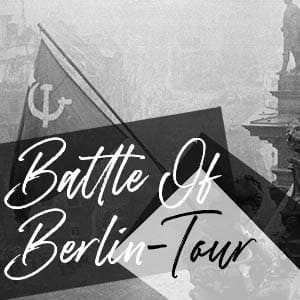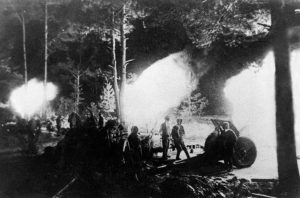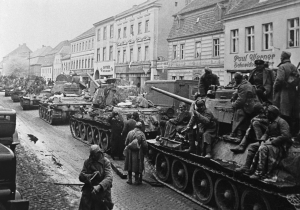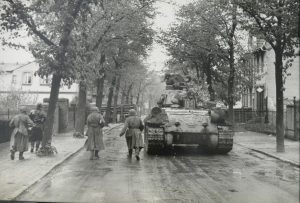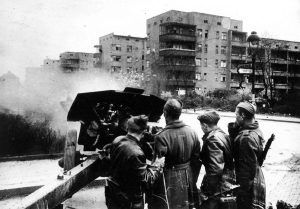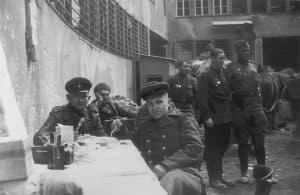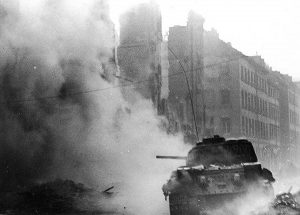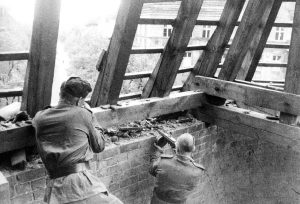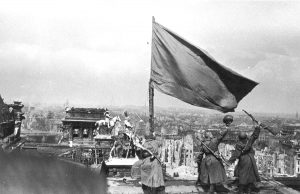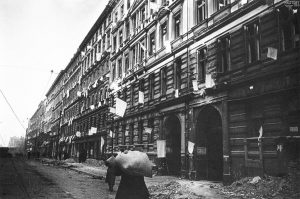The 9th Parachute Division of Herman Göring’s elite paratroopers had not absorbed the Soviet artillery’s percussive bombardment of the Seelow Heights particularly well.
Nor the initial onslaught of Red Army troops directed against them. Not that they could be blamed for being more than alarmed – vastly outnumbered as they were.
In-fact, these were only paratroopers by name; simply air force personnel transferred to combat duties for which they had no experience.
Contrary to any promises made by Göring that these men would hold their ground – or possibly even repel the Soviet advance – many had simply fled. Back through the line of the 9th Army and towards Berlin, when the massive columns as Zhukov’s Russian tanks surged out from the plateau in front of them.
Some of the remaining men were briefly gathered together by an SS volunteer panzergrenadier division, the SS Nordland, and conducted a successful counterattack against the Soviet advance. But by late on April 19th, the remnants of this strange assembly of Göring’s counterfeit elite would already have arrived within the Berlin defensive ring – and were now waiting for the main thrust of the Soviet forces on the capital.
As many of the other units fighting on the Seelow Heights had been subjected to the same repeated artillery bombardment, air attacks, and an onslaught of tanks and infantry – the situation on April 19th was now looking beyond dire for the assorted mix of German Army troops and SS fighters attempting to coordinate themselves in the chaos.
Yet the defenders of the ‘Gates of Berlin’ were still tasked with holding their line from the towns of Wriezen to Batzlow and Reichenberg. With the fortified towns of Prötzel and Strausberg behind them.
On the evening of April 18th, Nazi Propaganda Minister, Joseph Goebbels, had confirmed an order from the Reichs Chancellery, and thus directly from Hitler, that ‘all forces available, including Volkssturm, have been requested by the Ninth Army to hold second-line positions’. These men would be hurried to the frontline from Berlin in buses requisitioned for the purpose, only to find the positions they were expected to defend already overrun and the whole front set to crumble. On the 19th April, these men would join the general disarray but play little role in hindering the advance of the Soviet front.
Boys of the Hitler Youth, brought forward to man the roads to the rear of the main defensive force and the approaches to the Nazi capital – to facilitate an orderly withdrawal to positions closer to the city after the Soviet had overrun the Seelow Heights the day before – would soon be steamrolled by Red Army attacks.
As the Volkssturm men brought up were the last major reserves rounded up, along with a regiment of anti-aircraft defence units of the Great Germany Guards, this meant that the capital now stood largely defenceless.
The remaining troops in the east soon to be swept back by the Soviet push would bring with them the best chance of the Nazi capital’s survival.
Although they were currently fighting with the odds stacked against them.

Army Group Vistula chief, Gotthard Heinrici, was fond of touring the front and personally assessing the state of its defenses and the standing of the men. By now he had suitable reason to be alarmed. The rag tag groups of troops he had gathered on the Seelow Heights – that even included an assault group company wearing submariners uniforms – had struggled to maintain their positions and communications.
An able commander, Heinrici was also an exception to the hierarchy of the German Army in 1945 – as he was not afraid to express his concerns and contradict the orders of his superiors, even those issued directly by Adolf Hitler. Given the task of defending Berlin’s eastern approaches, the fifty-eight year old was considered by the Army General Staff as ‘the perfect example of a traditional Prussian soldier’ -yet he rarely looked like one. Instead preferring a frontline sheepskin jacket and First World War leather leggings to the general’s uniform that would match his rank and the Knight’s Cross with Swords and Oak-Leaves he had recently been awarded.
In preparation for dealing with the start of the Soviet offensive at the Seelow Heights on April 16th, Heinrici had issued orders that men from the same region should be split up in their units. As it was found troops were less likely to stop another man from their home deserting. Commanders of the 4th Panzer Army facing Ivan Konev’s 1st Ukrainian Front to the south would confiscate white handkerchiefs from their men – to stop them using them to surrender.
The Soviets must be stopped before the open country leading to Berlin.
Over the next 24 hours Heinrici’s command would be severely tested by Hitler’s orders to defeat the Red Army outside the city at all costs. His 9th Army, led by Theodor Busse, was in the process of being surrounded by Zhukov’s 1st Belorussian Front. And no doubt entirely annihilated. Unless drastic action was taken.
Although Heinrici must have realised the futility of his position, he was also reluctant to send his troops back to the streets of the city. Under the present circumstance, the man playfully dubbed ‘our poison dwarf’ by his troops knew that Berlin could not be defended. Tanks could hardly manoeuvre on the streets. Artillery had no line of sight.
To General Theodor Busse, retreat was comparable to treason. Hitler’s orders were to stand fast. Even though the 1st Belorussian Front had ripped through large sections of his defenses and were now rushing towards Berlin, with the forces of Ivan Konev’s 1st Ukrainian Front near Lübben and arching behind his 9th Army to cut off all reinforcements and chance of escape.
One day earlier, the 300,000 troops of Army Group B surrounded in the Ruhr Pocket of West Germany had finally given up fighting, after holding out for two weeks. Although those men had been lucky in one important respect: they had surrendered to the Americans.
Busse, who had served extensively on the Eastern Front, knew to expect no quarter from the Russians.
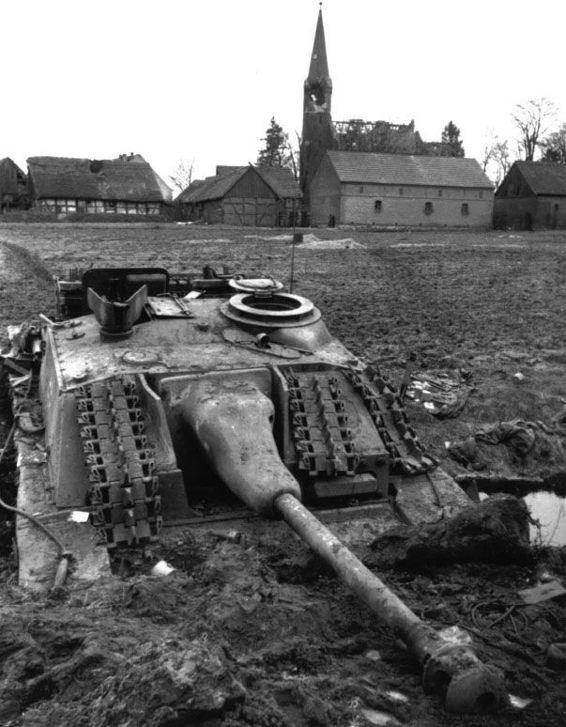
Despite the general disarray at the front, fanatical pockets of resistance still remained.
Although the First Guards Tank Army managed to take the town of Münchenberg by late afternoon on April 19th, it is credibly reported that 53 Soviet tanks were knocked out along the approaches to the hamlet.
Two Red Army tank brigades drove straight into an ambush laid by King Tigers of the SS Panzer Abteilung 503 near Prötzel, with the SS tankers managing to knock out over 70 Soviet tanks as heavy Panzers overlooking an open field near Grünow – covered in green and brown camouflage and firing the smokeless discharge of their 88mm shells – picked off armour of the 48th and 49th Guards Tank Brigade. The fighting would only stop as the three lead tanks ran out of ammunition and the group was targeted by a Soviet Katyusha rocket strike.
SS troops continued to fight in the area of Müncheberg on April 19th, with the Nordland Division pulling back to Prinzhagen and the Danish fighters further south mixing with Hitler Youth and remnants of the 18th Panzergrenadier Division to try to carry out a counterattack in the Buckow forest. Badly mauled they would pull back into the cover of the trees and the woodland burned around them with Soviet tanks firing into the tree-tops causing splinters to rain down on the defenders. The survivors would eventually make it to Strausberg to bind their wounds and patch up their vehicles.
The SS forces would avoid main roads during their withdrawal, especially Reichstrasse 1 – the direct road from the Seelow Heights to Berlin, as it was clogged with refugees from the east moving towards the city. Vehicles and farm carts would fight for space, all easy pickings for the Sturmovik ground attack aircraft flying in the air whose pilots were more than happy to machine guy convoys of retreating vehicles – civilian traffic or not. Berlin would see its second influx of refugees of the year, making it difficult for military and other official traffic to get through. As April 19th was a beautiful spring day it provided the Soviet air force with perfect conditions for operations.

By the end of the 19th there was a gap in the eastern front about 19 miles wide – from Wriezen to Behlendorf, with the remnants of the German 9th Army split into three parts. In the centre were the troops of General Helmuth Weidling, whose LVI Panzer Corp would eventually withdraw towards Berlin and the only bridges that could connect it to the main body to the south.
Frankfurt-am-Oder, which had been largely avoided by the Soviet forces at the main body of Zhukov’s 1st Belorussian struck further north at the Seelow Heights, was to be partially abandoned. With the garrison there moving to the west bank of the river to defend fallback positions – and wait to be surrounded.
At this time it would still have been possible to remove the remaining elements of the German 9th Army fighting near the River Oder to Berlin to continue resistance in the capital. Yet Hitler continued to point-blank refuse the urgent requests coming from Army Group Vistula to be reassigned elsewhere.
As a result of the success of Georgy Zhukov’s 1st Belorussian Front at the Seelow Heights and the Oder Front in general, a substantial chunk of the German 9th Army would be encircled before it could retreat to Berlin.
But not before exacting a devastating toll on the Soviet forces.
Stalin’s Red Army would finally move beyond the Seelow Heights on April 19th – but at a heavy price. Over the course of this mammoth confrontation, the 1st Belorussian Front would lose nearly three times as many men as the German defenders. From here ahead it would be open country.
As the Soviet front crept closer to Berlin.
And in the evening of April 19th, another Royal Air Force raid arrived to harass the city and its inhabitants. Seventy nine Mosquitos would attack, with all returning home safely afterwards.
**
Our Related Tours
Want to learn more about the Battle of Berlin? Check out our Battle of Berlin tours to explore what remains of this important urban battlefield.
To learn more about the history of Nazi Germany and life in Hitler’s Third Reich, have a look at our Capital Of Tyranny tours.
Bibliography
Beevor, Antony (2003) Berlin: The Downfall 1945 | ISBN 978-0-14-028696-0
Hamilton, Aaron Stephan (2020) Bloody Streets: The Soviet Assault On Berlin | ISBN-13 : 978-1912866137
Kershaw, Ian (2001) Hitler, 1936–1945: Nemesis | ISBN 0-393-04994-9
Le Tissier, Tony (2010) Race for the Reichstag: the 1945 Battle for Berlin | ISBN: 978-1848842304
Le Tissier, Tony(2019) SS Charlemagne: The 33rd Waffen-Grenadier Division of the SS | ISBN: 978-1526756640
Mayo, Jonathan (2016) Hitler’s Last Day: Minute by Minute | ISBN: 978-1780722337
McCormack, David (2017) The Berlin 1945 Battlefield Guide Part I the Battle of the Oder-Neisse | ISBN: 978-1781556078
McCormack, David (2019) The Berlin 1945 Battlefield Guide Part II The Battle of Berlin | ISBN: 978-1781557396
Moorhouse, Roger (2010) Berlin at War | ISBN: 978-0465028559
Ryan, Cornelius (1966) The Last Battle | ISBN 978-0-671-40640-0
Sandner, Harald (2019) Hitler – Das Itinerar, Band IV (Taschenbuch): Aufenthaltsorte und Reisen von 1889 bis 1945 – Band IV: 1940 bis 1945 | ISBN: 978-3957231581
Shirer, William L. The Rise and Fall of the Third Reich | ISBN 978-1451651683.

